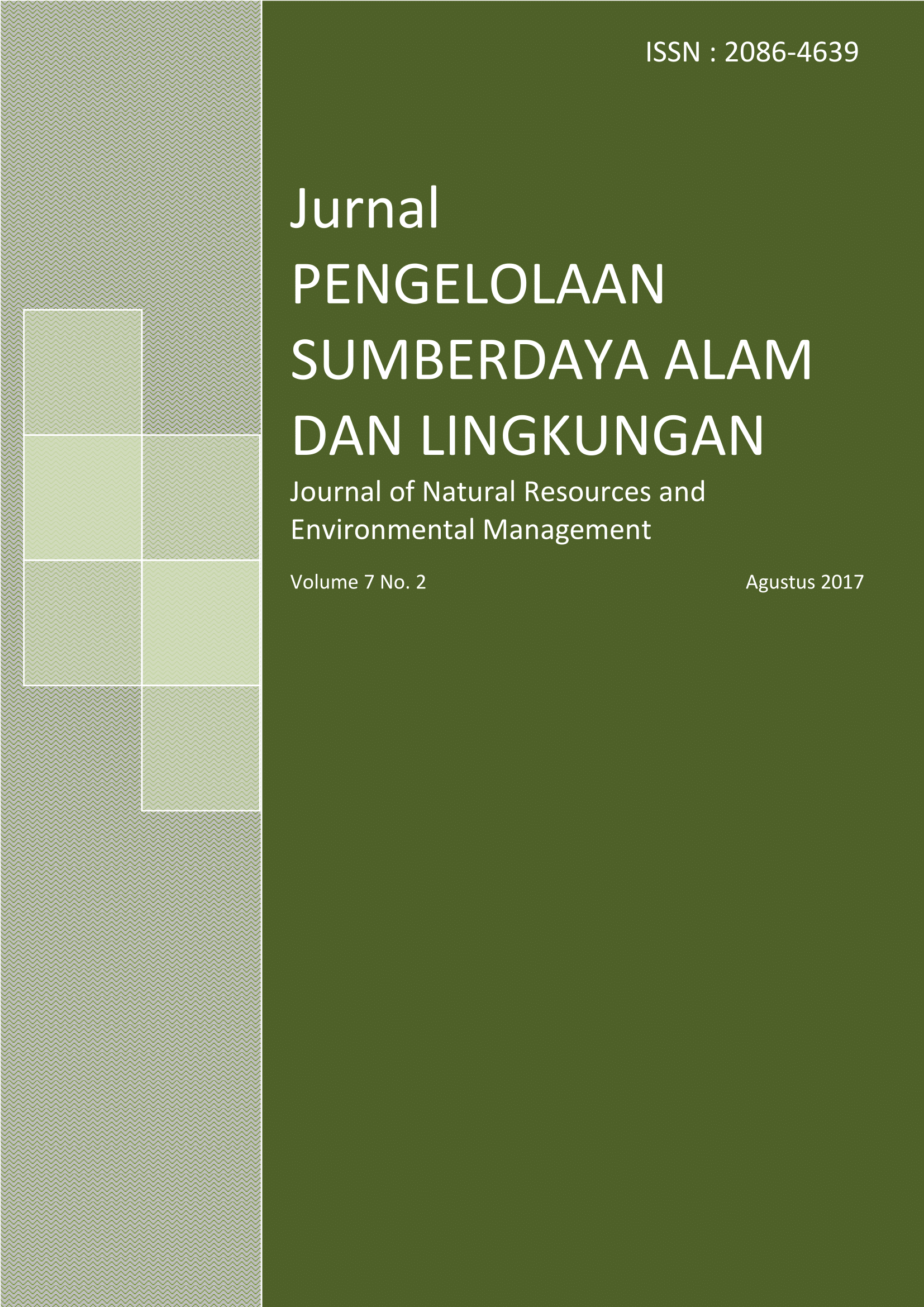EVALUASI EMERGY PENGEMBANGAN SISTEM BUDIDAYA UDANG SUPRA INTENSIF DI KAWASAN PESISIR MAMBORO, KOTA PALU, PROVINSI SULAWESI TENGAH
Abstract
Indonesia should pay greater attention on aquaculture due to a continous decrease in capture fisheries production. Shrimp is an excellent fishery commodity consumption in the global market, but the availability of supply is not yet fulfilled. The supra intensive aquaculture system has believed as a solution method for shrimp production. This study was trying to analyze the energy and emergy flow inside the supra intensive aquaculture system. Further analysis was done with emergy indices calculation to predict the future application of supra intensive system. The result of study shows the energy required in shrimp harvested from supra intensive system (transformity) was 1,12E+10 sej/g shrimps. This number represents it is needed more energy to produce per gram shrimps in supra intensive system compared to conventional shrimp pond in Ecuador and in Brazil. System more likely depend on purchased input which was indicated by very high EIR and ELR but in contrary relatively low EYR. Supra intensive aquaculture systems tend to be unsustainable in the long term by the very low value of ESI.
References
[2] [SCI] Shrimps Club Indonesia, 2015. Launching Teknologi Tambak Supra Intensif, Oktober 2015, Mam-boro.
[3] Boyd, C., B. W. Green, 2002. Coastal Water Quality Monitoring in Shrimp Farming Areas: An Example from Honduras Report. World Bank, NACA, WWF and FAO Consortium Program on Shrimp Farming and the Environment.
[4] Brown, M.T., S. Ulgiati S, 1997. Emergy-based indices and ratios toevaluatesustainability: monitoring econo-mies and technology towardenvironmentally sound in-novation. Ecol. Eng. 9 (1/2), pp. 51–69.
[5] Brown M. T., and S. Ulgiati, 2004. Energi quality, emer-gy, and transformity: H.T. Odum’s contributions to quantifying and understanding systems. Ecological Modelling. Elsevier, pp. 201-213.
[6] Brown M. T., S. Ulgiati, 2004. Encyclopedia of energi. A environmental accounting. Emergy and environmental decision making. John Wiley & Sons, New York.
[7] Brown, M.T. and E. Bardi, 2001. Handbook of Emergy Evaluation Folio 3: Emergy of Ecosystems. Center for Environmental Policy, University of Florida, pp. 90, Gainesville.
[8] Cao L., W. Wang, Y. Yang, C. Yang, Z. Yuan, S. Xiong, J. Diana, 2007. Environmental Impact of Aquaculture and Countermeasures to Aquaculture Pollution in China. Env Sci Pollut Res. 14 (7), pp. 452–462.
[9] Cavalett, O., J. F. Queiroz, E. Ortega, 2006. Emergy as-sessment of integrated production systems of grains, pig and fish in small farms in the South Brazil. Ecological Modelling. 193, pp. 205-224.
[10] Coelho, O., E. Ortega, V. Comar, 2003. Balanço de emergia do Brasil e Dados de 1996, 1989 e 1981 (Emer-gy balance of Brazil e Statistics of 1996, 1989 and 1981). Statistics 2003. Available from: (accessed 01.10.09.) http://www.fea.unicamp/docents/ortega/hm.
[11] Damar, A., 2004. Eutrofikasi perairan pesisir. Makalah disampaikan pada peringatan hari bumi di Institut Per-tanian Bogor, Bogor.
[12] Lefroy, E., T. Rydberg, 2003. Emergy evaluation of three cropping systems in southwestern Australia. Eco-logical Modelling. 161, pp. 193-209.
[13] Lima, J.S.G., E. C. Rivera, U. Focken, 2012. Emergy evaluation of organic and conventional marine shrimp farms in Guaraira Lagoon, Brazil. J. Cleaner Prod. 35, pp. 194–202.
[14] Londono, N. A. C., D. G. Suarez, H. I. Velasquez, 2014. Emergy Evaluation A Tool for the assesment of Suistainibility Development. Int. Journal of Engineering. 4(2), pp. 172-178.
[15] Odum, H. T., 1996. Environmental Accounting, Emergy and Decision Making. John Wiley and Sons, New York.
[16] Odum, H. T., 1996. Environmental accounting: Emergy and environmental policy making. John Wiley and Sons, New York.
[17] Odum, H. T., E. C. Odum, 2000. Modelling for all scales: An introduction system Simulation. University of Florida. Academic Press, San Diego. California.
[18] Odum, H. T., M. T. Brown, S. Ulgiati, 2000. Ecosystems as Energetic Systems. In Jørgensen, S.E., Müller, F., (eds.) Handbook of Ecosystems Theories and Manage-ment. Lewis Publishers, London.
[19] Odum, H.T., J. E. Arding, 1991. Emergy Analysis of Shrimp Mariculture in Ecuador. Coastal Resources Cen-ter, University of Rhode Island, Narraganset, p. 114.
[20] Ortega, E., 2006. Tabela de transformidades (Table of transformity). Available from: (accessed 01.10.09.).http://www.fea.unicamp/docents/ortega/livro/index.htm.
[21] Ulgiati S, M T. Brown. 1998. Monitoring patterns of sustainability in natural and man-made ecosystem. Else-vier. Ecological Modelling 108, pp. 23-36.
[22] Voora, V. and C. Thrift, 2010. Using emergy to value ecosystem goods and services. International institute for sustainable development. Winnipeg, Manitoba Canada.
[23] Williamson, T. R., D. R. Tilley, E. Campbell. Emergy analysis to evaluate the sustainability of two oyster aq-uaculture systems in the Chesapeake Bay. Elsevier. Eco-logical Engineering 85 (2015), pp. 103–120.
[24] Zhang, L. X., S. Ulgiati, Z. F. Yang, B. Chen, 2011. Emergy evaluation and economic analysis of three wet-land fish farming systems in Nansi Lake area, China. Journal of Environtmental Managemant, 483-494.
Authors
Authors who publish with this journal agree to the following terms:
- Authors retain copyright and grant the journal right of first publication with the work simultaneously licensed under a Creative Commons Attribution License that allows others to share the work with an acknowledgement of the work's authorship and initial publication in this journal.
- Authors are able to enter into separate, additional contractual arrangements for the non-exclusive distribution of the journal's published version of the work (e.g., post it to an institutional repository or publish it in a book), with an acknowledgement of its initial publication in this journal.
- Authors are permitted and encouraged to post their work online (e.g., in institutional repositories or on their website) prior to and during the submission process, as it can lead to productive exchanges, as well as earlier and greater citation of published work (See The Effect of Open Access).





